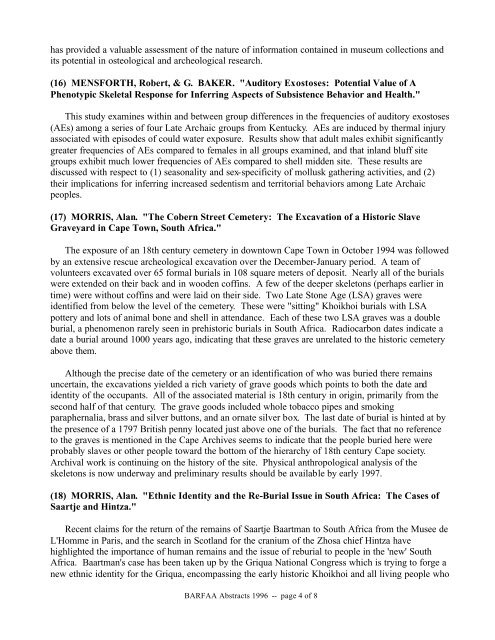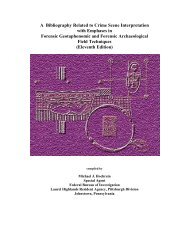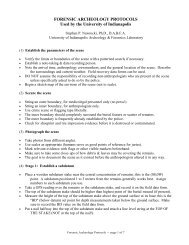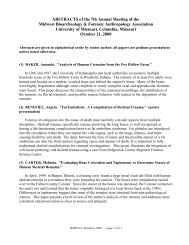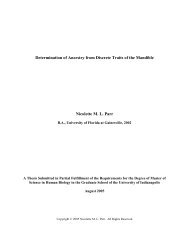Abstracts - University of Indianapolis Archeology & Forensics ...
Abstracts - University of Indianapolis Archeology & Forensics ...
Abstracts - University of Indianapolis Archeology & Forensics ...
Create successful ePaper yourself
Turn your PDF publications into a flip-book with our unique Google optimized e-Paper software.
has provided a valuable assessment <strong>of</strong> the nature <strong>of</strong> information contained in museum collections and<br />
its potential in osteological and archeological research.<br />
(16) MENSFORTH, Robert, & G. BAKER. "Auditory Exostoses: Potential Value <strong>of</strong> A<br />
Phenotypic Skeletal Response for Inferring Aspects <strong>of</strong> Subsistence Behavior and Health."<br />
This study examines within and between group differences in the frequencies <strong>of</strong> auditory exostoses<br />
(AEs) among a series <strong>of</strong> four Late Archaic groups from Kentucky. AEs are induced by thermal injury<br />
associated with episodes <strong>of</strong> could water exposure. Results show that adult males exhibit significantly<br />
greater frequencies <strong>of</strong> AEs compared to females in all groups examined, and that inland bluff site<br />
groups exhibit much lower frequencies <strong>of</strong> AEs compared to shell midden site. These results are<br />
discussed with respect to (1) seasonality and sex-specificity <strong>of</strong> mollusk gathering activities, and (2)<br />
their implications for inferring increased sedentism and territorial behaviors among Late Archaic<br />
peoples.<br />
(17) MORRIS, Alan. "The Cobern Street Cemetery: The Excavation <strong>of</strong> a Historic Slave<br />
Graveyard in Cape Town, South Africa."<br />
The exposure <strong>of</strong> an 18th century cemetery in downtown Cape Town in October 1994 was followed<br />
by an extensive rescue archeological excavation over the December-January period. A team <strong>of</strong><br />
volunteers excavated over 65 formal burials in 108 square meters <strong>of</strong> deposit. Nearly all <strong>of</strong> the burials<br />
were extended on their back and in wooden c<strong>of</strong>fins. A few <strong>of</strong> the deeper skeletons (perhaps earlier in<br />
time) were without c<strong>of</strong>fins and were laid on their side. Two Late Stone Age (LSA) graves were<br />
identified from below the level <strong>of</strong> the cemetery. These were "sitting" Khoikhoi burials with LSA<br />
pottery and lots <strong>of</strong> animal bone and shell in attendance. Each <strong>of</strong> these two LSA graves was a double<br />
burial, a phenomenon rarely seen in prehistoric burials in South Africa. Radiocarbon dates indicate a<br />
date a burial around 1000 years ago, indicating that these graves are unrelated to the historic cemetery<br />
above them.<br />
Although the precise date <strong>of</strong> the cemetery or an identification <strong>of</strong> who was buried there remains<br />
uncertain, the excavations yielded a rich variety <strong>of</strong> grave goods which points to both the date and<br />
identity <strong>of</strong> the occupants. All <strong>of</strong> the associated material is 18th century in origin, primarily from the<br />
second half <strong>of</strong> that century. The grave goods included whole tobacco pipes and smoking<br />
paraphernalia, brass and silver buttons, and an ornate silver box. The last date <strong>of</strong> burial is hinted at by<br />
the presence <strong>of</strong> a 1797 British penny located just above one <strong>of</strong> the burials. The fact that no reference<br />
to the graves is mentioned in the Cape Archives seems to indicate that the people buried here were<br />
probably slaves or other people toward the bottom <strong>of</strong> the hierarchy <strong>of</strong> 18th century Cape society.<br />
Archival work is continuing on the history <strong>of</strong> the site. Physical anthropological analysis <strong>of</strong> the<br />
skeletons is now underway and preliminary results should be available by early 1997.<br />
(18) MORRIS, Alan. "Ethnic Identity and the Re-Burial Issue in South Africa: The Cases <strong>of</strong><br />
Saartje and Hintza."<br />
Recent claims for the return <strong>of</strong> the remains <strong>of</strong> Saartje Baartman to South Africa from the Musee de<br />
L'Homme in Paris, and the search in Scotland for the cranium <strong>of</strong> the Zhosa chief Hintza have<br />
highlighted the importance <strong>of</strong> human remains and the issue <strong>of</strong> reburial to people in the 'new' South<br />
Africa. Baartman's case has been taken up by the Griqua National Congress which is trying to forge a<br />
new ethnic identity for the Griqua, encompassing the early historic Khoikhoi and all living people who<br />
BARFAA <strong>Abstracts</strong> 1996 -- page 4 <strong>of</strong> 8


